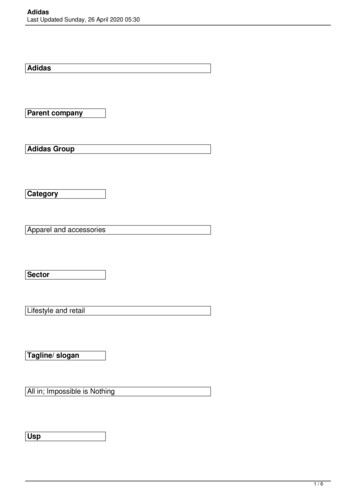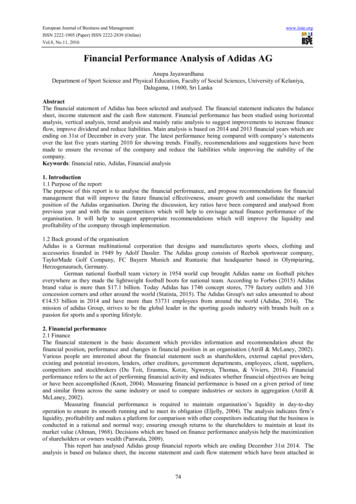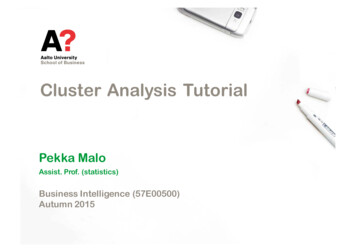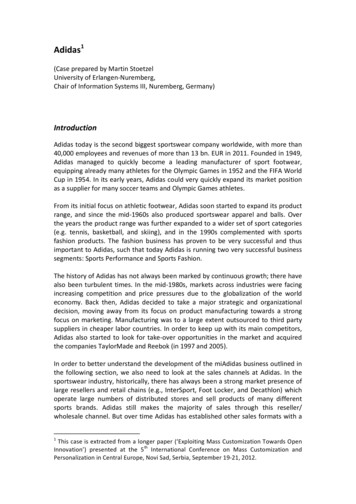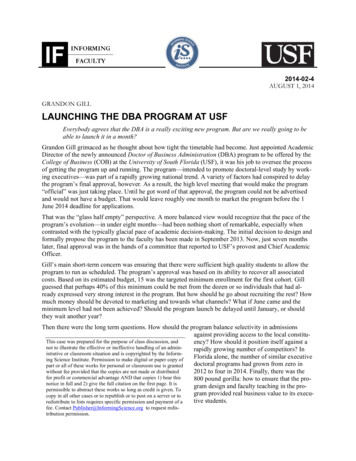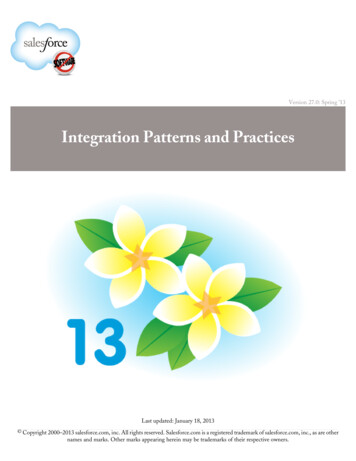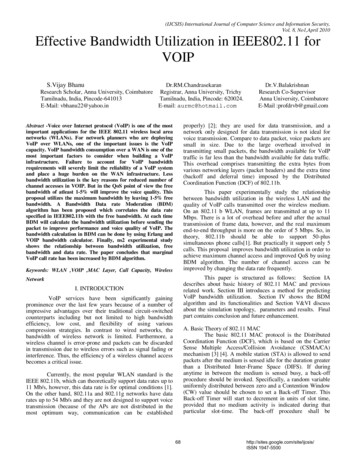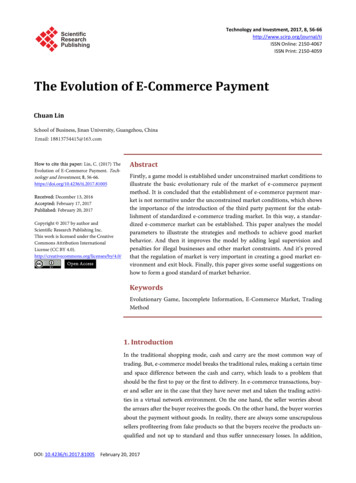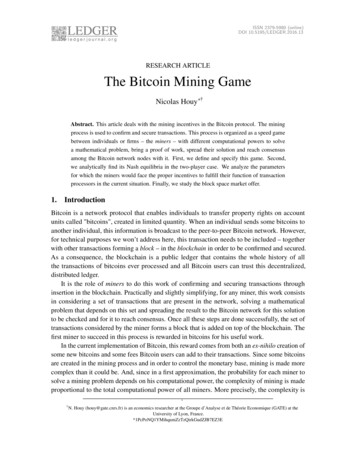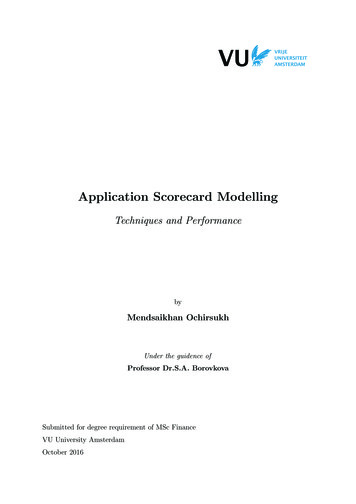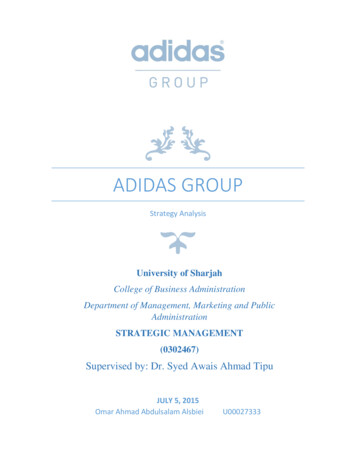
Transcription
ADIDAS GROUPStrategy AnalysisUniversity of SharjahCollege of Business AdministrationDepartment of Management, Marketing and PublicAdministrationSTRATEGIC MANAGEMENT(0302467)Supervised by: Dr. Syed Awais Ahmad TipuJULY 5, 2015Omar Ahmad Abdulsalam AlsbieiU00027333
Table of Contents:TitlePage Number3IntroductionField Description Using Five Forces model4,5,66,7PESTEL AnalysisVision & Mission objectives8Strategy Building Blocks (resources & capabilities)99,10SWOT Analysis10,11,12,13Strategy DiamondCorporate level & business level Strategy13,1415VRINE model16,17Value chainCAGE distance analysis18Conclusion19References201
Introduction:In every industry there are some firms who take the lead in it, & the customers trust intheir products. This project discusses the management strategy of the German companythat started its journey very long time ago to become a key competitor in the field. Adidasgroup which is the leading sports company in Europe & the world's 2nd leading companyin the sports field after Nike Ink. The brand portfolio is consisted of Adidas, Taylormade, Reebok, & Rock-port. The brands of the Adidas Group complement each other ina unique way to help athletes perform better, play better, feel better. Our products breakrecords, set trends, and make history, every day, all over the world.The main aim of the project is to find the points where Adidas has a competitiveadvantage in, & where it has weaknesses, providing possible solutions or changes thatcould make the group in a better position.The project's structure is as follow: After introducing the project, several elements of thestrategic management course will be discussed & how Adidas is doing in each. Startingwith a discretion of the sports sector using the five forces model, PESTEL analysis, thenthe Vision & Mission statements are going to be analyzed critically, then the resources &capabilities of the firm are going to be identified, SWOT analysis, then the strategydiamond is going to be discussed in detail, after that, an explanation of Adidas group'scorporate level & Business level strategy will be given, VRINE model, Value chain, &ending with the Cage distance of the firm. Then a conclusion that will summarizes thekey points, findings & recommendations for the company, followed by the references.2
Field Description Using Five Forces model:The purpose of this model is conducting an external analysis by measuring the: degree ofrivalry, power of suppliers, and power of buyers,threat of substitutes, and threat of new intranets.Rivalry: this can be measured using many sub-Exit barriers4Industry concentration 4measures that are going to be shown in a tableFixe cost5after this paragraph. The first step is to identifyIndustry growth3the main competitors in the field, and in theOvercapacity3sports field they are Nike Ink & Puma who areProduct differences4the main two competitors of Adidas group. ForSwitching costs5sure the industry of sports is a very competitiveBrand identity2Diversity of rivals4Corporate stakes4Average3.8market and competitiveness is based on price,quality, & many other factors. And according towhat've been taught in Strategic managementcourse we've came with the sub-measures shownin the table below to get an average degree of rivalry of 3.8 which set Adidas group as avery key competitor in the field.Power of Supplier:The first step to measure the supplier power is to know who the main suppliers forAdidas group are, but it wasn't clear who theSupplier concentration2whole list of its suppliers and that’s rare to beImportance of volume4done. But we collected some information of howInput differentiation2Adidas manages its supply chain system to makeInput effect on differentiation 3the sub-measures, and we got an average of theSwitching costs of firms inindustry2suppliers of Adidas group don’t have aPresence of sub inputs2significant power.Threat of Forward integration 2main suppliers are. The group discloses thesupplier power of 2.6. Such result refers to thatCost relative to total purchase insupplier industry4Average32.6
Buyer Power:Buyer concentration2Importance of volume2Differentiation in sports2performance, & the second group of buyers areSwitching costs of customers4normal customers who like comfort stylishPresence of sub inputs4apparel, footwear & sports accessories. The subThreat of backward integration 3measures for the buyer power are going to bePrice sensitivity3expressed in the table below.Buyer information2two main categories of buyers in the case of theGerman company: professional athletes whoneed Adidas's products to maximize theirAverage2.75Threat of tes while they aren't the same! AsSwitching cost3discussed before, Adidas's main competitors areBuyer inclination of substitute 3Nike Ink & Puma. But its substitutes wouldPrice of performance trade-off ofsubstitute3likely be firms that produce non-sport footwear,Variety of substitutes4clothing and accessories for example. And thisNecessity of product3measure is to check whether the substitutes makeAverageapparel, or accessories like suits and formal3.2a threat for Adidas group or not. By logic it's notlikely for athletes or people who already like sports apparel to change to formal clothingand such stuff, but by making the sub-measures in the following table, and getting anaverage of 3.2 we found out that substitutes might make a threat for the sports brand ingeneral.4
Threat of New Entrants:To conduct a new business, the firstAverage profitability of incumbents1where to get the capital. Studies ofIncumbents have a cost advantage3finance had proved that people preferLearning curve advantage for incumbents 5to make their business leveragedAccess to inputs5(part of their own capital, and theGovernment policy (regulation)5other part from financial institutions)Economies of scale4but no one will trust to put his moneyCapital requirements1in a new business where strong rivalsBrand identity1Switching costs1Access to distribution (gates)3Expected relation2Proprietary products4Average2.5thing you need to think about is fromexists unless the new entrant has anaccess to the field's resources, andhas a strong brand name in otherfields in a way the company will gainthecustomerstrust.Thesub-measures in the table shown, has anaverage of 2.5 of the threat of newentrants, which means that new entrants has a significant threat on Adidas Group.PESTEL Analysis:Political Factors:Adidas puts a great emphasis on political stability in all the countries it operates in. riskssuch as terrorism, war, expropriation, nationalization, civil unrest and significant changesto trade policies (Lawson 2006) leads a significant loss in time and money because therewill be delay in shipments and product delivery. And not all the countries have the sametax system which will cause in more complexity. Also they can’t take advantage of thelow labor salary everywhere, because a few countries like china for example offer lowlabor salaries. (Essays, 2003 - 2015)5
Economic Factors:The economic factors that affect Adidas profitability are Taxation, Inflation,unemployment and per capita income. And unstable stock market which is caused due tothe fluctuation of interest’s rates and thus the growth rate will be affected as well.(Essays, 2003 - 2015)Sociocultural Factors:The social factors that affect Adidas innovation are culture, language, religion, race,gender, buying habits and life style. All those factors decide how Adidas will operate andimplement its strategy. Like if it will make a commercial on an Islamic TV, it shouldconsider a proper outfit. (Essays, 2003 - 2015)Technological Factors:In any big and well known company like Adidas it must possess unique technologies thatdistinguish it from its competitors. Not only it will put her in front of the othercompetitors, it will also speed up its production, enhance its production quality, savetime, energy and effort. Adidas didn’t use the technological factor in the productionprocess only; it used it in the products itself like the smart ball that uses smart phones tooperate with the ball data collection. And on the internet, like the online store to facilitatethe purchasing experience.Environmental Factors:Adidas makes sure all its factories doesn’t use restricted substances, reduce VolatileOrganic Compounds emissions, and follow the “better Place” program they started backin 2007, Its aim is to encourage the use of more sustainable products withoutcompromising their functional and quality performance. (Adidas, 2015), (Essays, 2003 2015)Legal Factors:Adidas because it’s a big sportswear company, it should be aware of all legal constraintsthat include: Press Complaints Commission (PCC), Trade Descriptions Act, Sales andSupply of Goods Act, Independent Television Commission (ITC), Advertising StandardsAuthority (ASA). So Adidas should be aware of sales, import and export, product names6
selection, commercials and many more for not to be plagiarized from a third partytrademark. (Essays, 2003 - 2015)Vision & Mission objectives:Vision:There is a list of Dos and Don'ts for the vision statement that companies should considerwhen setting their vision statement, & of this list Adidas group's vision statement isgraphic, feasible, forward looking & directional, focused, and has a wiggle room. But it'slong and relies on superlatives as wellMission:We strive to be the global leader in the sporting goods industry with brands built on apassion for sports and a sporting lifestyle! This mission statement identifies the firm'sproduct, specifies the buyer needs it seeks to satisfy, identifies customer groups it isendeavoring to serve, & sets the firm apart from rivals.7
Strategy Building Blocks (resources & capabilities):The resources and capabilities are the key driving forces for a company to achieve itscompetitive advantages. Adidas utilizes its key resource and capabilities to create valueand performance excellence.The resource and capabilities of Adidas are :Key Resources (tangible & intangible) / Core Competencies: Strategic Innovation Integrated Research and Development (including technological resources) Distribution Network Supplier relation Efficient Employees Good Reputation as mid-priced brand in Industry Diverse brand portfolio (including merging with reebok)Key Capabilities: Outsourcing Capability Product design Capability Supply Chain Capability Effective Distribution Capability Financial control Diversification CapabilitySWOT Analysis:It stands for strength, weaknesses, Opportunity, & threats. And the main purpose of thisanalysis is to find the company's strength points and to link it with the threats that mightaffect the company, & to find the weaknesses of the company and find possibleopportunities to fix these weaknesses.For Adidas group the strength point is its innovation capability, & this strength power canbe linked with continuous change in taste of customers; because one day they might bebuying Adidas's products, and then in the other day they just don't like it anymore. So8
Adidas utilizes its innovation to come up with new ideas every year or season, to keep upwith the changing taste of customers.As for the weakness point, there are many rivals who are producing products with thesame concept of Adidas's products and made with the same raw materials, and a possiblesolution for Adidas is to create its own raw material, and this is what happened when theGerman sports company partnered with German chemical company BASF to come upwith its own unique special shoe cushioning material that makes the shoe extremely lightand adapt with any climate to increase the performance of athletes.Strategy Diamond:The purpose of this analysis for each company is to know which category it has a corecompetence in, and the categories of the strategy diamond are: Arenas, Vehicles,Differentiators, Economic logic, & StagingArena:The main question in this category would likely be: Where are we going to be active?What product categories? What channels? Which market segments? Which geographicareas? What core technologies? & what is the value creation strategy?Adidas group is consisted of many brands as mentioned before, so it has many differentproducts, but mainly it functions in the sports field. It has the sport performance productslike the F series football shoes (F5, F10, F15 etc.), sports casual products that can befound in Adidas Originals brand, and other sport accessories.All these products are sold through different channels: Retailers like (Sun & Sand sports,Stadium, & many other sports Retailers). Adidas has its own Wholesale to manufactureits products & distribute it to its own retail shops around the world. And products canalso be purchased from Adidas group's website.The company is targeting customers who are interested in sports; they can be professionalathletes who need the right sports accessories to be able to give 110% of their powers.For such customers Adidas has developed many sports performance products usingunique technologies like the smart chip, smart ball, smart run watch, etc. and the9
extremely light shoes (Adidas 1 intelligent running shoes) called “micoach collection”.Or they can be normal customers whose taste in clothing tends to stylish comfortsportswear, and for those customers brands like Originals, Porsche' design, & Neon arecreated.Adidas group is functioning world widely in all regions: Europe, America, Africa, andMiddle East.As for the core technology that Adidas group uses is the continuous innovation throughthe years like when they started with they launched the special feature germen boot withthe screw studsVehicles:This category of the strategy diamond focuses on how will the firm achieve its goals andmake its sales?Adidas group has an internal development that can be expressed in the technologieswhich they are combining with their products, the special shoe cushioning materialcreated with German chemical company BASF. And for such development they can get apatent. This thing can be also considered as experimentationThe firm also has franchises all around the world.Differentiators:This category is where the core competence of any firm or company is determined, itseeks to define what makes the product or service of a particular company unique ordifferent than rivals in the same industry or field.Adidas group has many aspects that gives its products the competitive advantage:starting with the brand image: Adidas group uses a very intelligent way to promote itsproducts, by contracting with the best famous athletes in the world to advertise for itsproducts: for Adidas brand: Lionel Messi (#1 football player in the world), Gareth Bale(Richest football player in the world), Zinedine Zidane, David Beckham, & Pelé (Themost loved football players in the world). The brand doesn’t only focus on single keyplayers but the brand has numerous major kit deals with clubs worldwide, includingBayern Munich, Real Madrid, Chelsea, Milan, Ajax, and Flamengo. National teams10
sponsored include Germany, Spain, Russia, Japan, Colombia, Argentina, Mexico,Denmark, Wales, Paraguay, and Sweden. And it’s one of the official sponsors for manyleagues like UEFA Champions League, NBA league. In addition to many other famousathletes in other sports (Basketball, Tennis, Golf, Running etc.). The company alsocontracts with international celebrities who are considered as Role models for manygenerations like Snoop-dog, Kanye West, Pharrell-Williams, Justin Bieber, & Rita Ora(pop-stars), and many others. Such contracts lead to a very strong trustworthy image ofthe brand. This particular point can be counted for Adidas as a core competence, butother rivals have a good brand image as well, especially its #1 rival Nike-Ink which is theleading company in the sports field.So, in addition to the strong brand, Adidas is also known for its unique style of the threestripes design. The company's products are not only stylish, but they are also reliable &durable as well, they get the best of the athletes' performance, last for long time & handlethe worst climates.Economic Logic:This criteria of the diamond defines what logic the company follows to make profit andcover operating and other costs, weather it uses economies of scale, economies of scope,premium prices for unmatchable service or premium prices due to technology.Adidas group strategy includes both economies of scale & economies scope. This can beexplained by the fact that Adidas uses the same materials to produce many models of aparticular product & in a large quantity of each; in example: Adidas running shoes, inwhich they use the same cushioning material to make it very light & then they play withthe design.One other aspect they use to make profit is that they charge premium prices on somespecial products that are made with effort for athletes to increase their performances.Compared to its rival Nike Ink, Adidas has products with reasonable prices for all peopleto have, and some with premium prices.11
Staging:This category of the strategy diamond describes the evolution process of the company.The first step was in 1924 when Adi Dassler (The founding father) registered "GebrüderDassler Schuhfabrik" & stated that his mission is to provide athletes with the bestpossible equipment. And at the age of 49 Adi Dassler decided to start over again ®istered the "Adi Dassler Adidas Sports Schuhfabrik" in a small town calledHerzogenaurach & started working with only 47 employees. On the same day heregistered the shoes that also lead to the registration of the famous Adidas 3-stripes. Thespark that lead Adidas very famous is the miracle victory for Germany againstHungarians in 1945 world cup final because of the light shoes that were half the weightof the English football boot, this victory lead Adidas to become a household name onfootball pitches everywhere. Produce innovative products that make them better for once.Adi Dassler’s secret to success had an additional personal ingredient: he met with athletes(some of them even as visitors in Herzogenaurach), listened carefully to what they saidand constantly observed what can be improved or even invented to support their needs.The best of the best trusted Adidas and its founder from the beginning. And that wouldnot change throughout the decades to come.Acquired Salmon group in 1997. And acquire its rival Reebok in 2005, which was such asmart move to combine both companies' resources & capabilities.Corporate level & business level Strategy:Corporate level Strategy:This concept is to find the evolution process of the company, its horizontal & verticalintegration (which markets we're going to be active in).The vertical integration is the backward or the forward integration, the backwardintegration is when a manufacturer like Adidas who buys the materials needed inmanufacturing its products from other suppliers, becomes the supplier of these rawmaterials, in other words it can be expressed as (self-independence). But Adidas doesn'thave the backward integration since it doesn't supply the raw materials needed to make12
its products. Only at some point when it cooperated with German chemical companyBASF to make the special couching for its running shoes, but it doesn't count anywaysbecause they aren’t making the couching.As for the forward integration, it's when a manufacturer who distributes its products togroup of retailers, become a retailer for its products. Apple ink as an example, when itused to sell its products only through retailers, but it evolved to have its own retail shops(Apple store) all around the world. The same can be said about the German sports group,it used to sell its products only through retailers like sun & sand sports, Stadium, GoSports, etc. but it evolved to have its own Adidas retail shops all around the world aswell.The second part of the corporate level strategy is the h
The main aim of the project is to find the points where Adidas has a competitive advantage in, & where it has weaknesses, providing possibl
